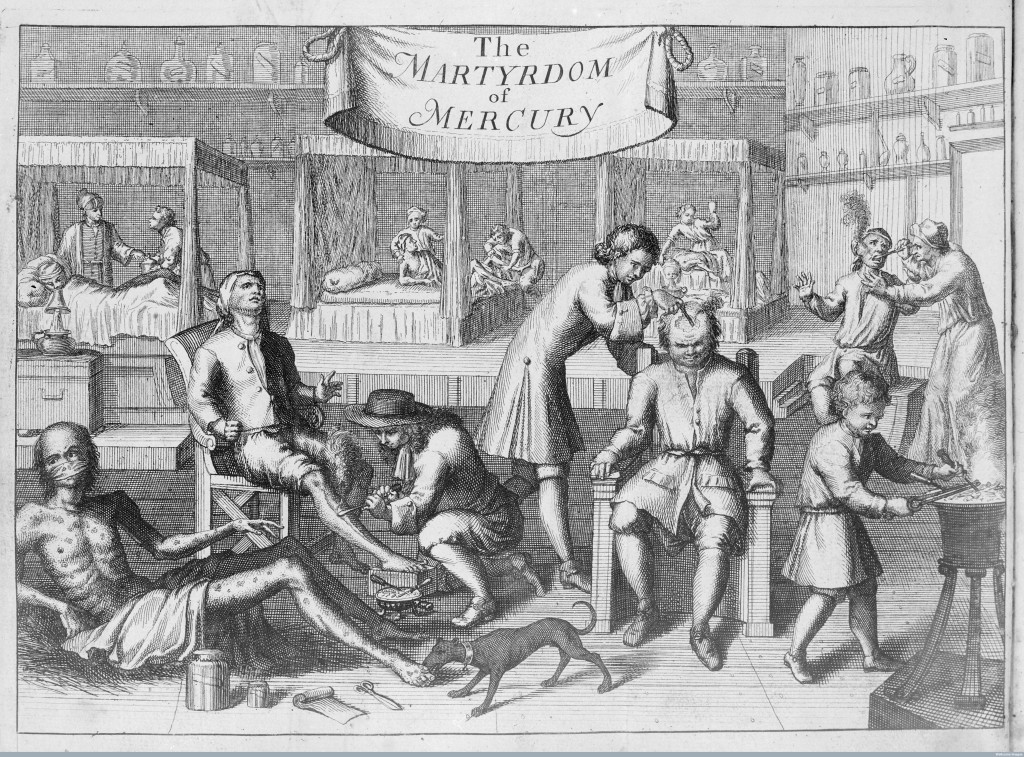Boyd Brogan
If you’re looking for evidence about bodies in history, it doesn’t get harder than skeletons. Opening this three-day conference at the University of Cambridge on the historical relationship between sexually-transmitted infections (STIs) and fertility, bioarchaeologist Charlotte Roberts argued that it is human remains, not documents, that constitute the primary record of human health. Roberts explained how, within bioarchaeology, the sub-field of palaeopathology examines the traces that certain diseases leave in human bones. Syphilis is one of them. It bends legs out of shape, and corrodes the skull like drops of acid. Cranial caries and sabre shins; this, Roberts suggested, is where the real ‘lived experience’ of historical men and women is to be found.

But skeletons still have to be interpreted. ‘Parturition scars’, once thought to reveal the number of times a person had given birth, are now discredited. Studies of the ‘Columbian question’ – whether syphilis originated in Europe or the Americas – may be influenced by which samples are chosen from where, which tests get re-tested, and how the testers have been trained. Some influential research on bone marks left by different types of syphilis, based on evidence from twentieth-century Uganda, might have been (mis)shaped, Roberts thought, by ‘preconceptions about modernisation and sexual behaviour’. Problems like these were far from being a thing of the past. To be sure about syphilis you have to have the skull, Roberts asserted on day one. But very often the skull is what’s missing, her colleague Rebecca Redfern explained on day three. So could one still draw conclusions about syphilis? Well, possibly with a trained eye one could be reasonably confident . . . Under the microscopic scrutiny this conference provided, it began to look as though certain ideas about scientific certainty were, well, history.
In fact, it seemed at times as if no scrap of evidence, scientific or otherwise, would be allowed to go about its business unhindered. There is a traditional Oxbridge view of interdisciplinarity as polite conversation over lunch, to which the acronymic title of CRASSH, Cambridge’s brilliant and beautiful Centre for Research in the Arts, Social Sciences and Humanities, seems like a calculated affront. CRASSH makes interdisciplinary work sound noisy and dangerous. It was the perfect home for this conference, which was full of clashing perspectives on questions that kept revealing new layers of ethical and scientific complexity. The conference’s principal aim was to investigate the possible effects of STIs on premodern population growth. Without antibiotic treatment, STIs frequently cause infertility. Might this have formed a natural mechanism of population control in the pre-antibiotic era, in which increases in sexual activity were therefore likely to be countered by declining birthrates?
Co-organisers Rebecca Flemming (Classics), Lauren Kassell (History and Philosophy of Science), and Simon Szreter (History) used this overarching theme to bring together speakers from unusually diverse fields. Palaeopathologists (two of them), surgeons, demographers, cultural historians, classicists, digital editors, and a former director of public health for Papua New Guinea, were all scheduled in productively discomfiting proximity. As Szreter observed, everyone was out of their depth, and not much was left to cling to, as paper after paper spun the issues through 180 degrees. In eighteenth-century London, as much as 75% of the population had been infected with gonorrhoea by the age of 35. Or that same London was a place of dull and prudish respectability, where virginal brides stayed faithful and married late. Chlamydia was as old as the dinosaurs, as we could tell from its genome. Or it was a ‘disease without a history’ whose emergence had had much to do with legitimating the new specialism of Genito-Urinary Medicine (GUM), and the little we know about its genome suggests its origins to be recent. Psychological theories about postcolonial trauma had obscured the fact that much population decline in the developing world was caused by STIs. Or population decline was indeed caused by psychological factors, but different ones, among which was the misperception that STIs were rampant. Or infertility had been widely misattributed to STIs as a result of physicians’ prurience, when much of it was really caused by complications from earlier pregnancies. As the conference progressed, some of those dizzying ors started to resolve themselves into ands, and mosaics of contradiction became research pictures of three-dimensional complexity.
It also became clear that many of these questions, as Kassell observed, revolved around a larger one: ‘how should we write the history of diseases?’ Claudia Stein’s inquiry into the fraught relations between historians and biologists showed that similar debates around the historiography of syphilis had taken place in early twentieth-century Germany. Why should the history of STIs, in particular, elicit such responses? Perhaps because it offers a particularly pungent combination of medical and moral ideas. Or, perhaps, could the unexamined assumptions that underlie different approaches to the study of the past be brought to light through the various kinds of concealment with which these illnesses have historically been surrounded? Some of this excavation was conducted overtly, within individual papers like Stein’s, and some of it emerged from the cracks between them. Olivia Weisser showed that eighteenth-century STIs often figured in medical ‘detective stories’, in which authoritative physicians exposed duplicitous patients. Roy Scragg, the conference’s distinguished guest of honour, explained how he’d done something similar with lipiodol x-rays in 1950s Papua New Guinea. Gonorrhoea’s later, sterilising stages in female patients cause internal pain but lack external symptoms. Scragg’s technology revealed an epidemic, which he was then able to treat. Weisser’s narrative raised Foucauldian suspicions about clinical authority and medical surveillance; Scragg showed how x-ray insights could bring women’s invisible suffering to light. The differences offered their own scan of interdisciplinary tensions.
The conference’s remit was explicitly historical – this was deemed to exclude HIV but not chlamydia, a distinction that looked increasingly shaky – but the present proved hard to keep out. Several papers addressed pelvic inflammatory disease, a painful cause of infertility that lacks external symptoms and is often wrongly attributed to STIs. That same day, The Guardian devoted its front page to the ‘hidden toll’ of endometriosis, similarly painful, similarly associated with infertility, and similarly likely to be misdiagnosed. As politicians argued about how many refugees Britain could take, the themes of migration and inter-cultural contact introduced by Roberts’s exposition of the ‘Columbian question’ continued to make themselves felt. Tim Bayliss-Smith debated Aphrodisian cultures and virgin soil in the pre-colonial South Pacific; Hugh Taylor revealed how the trachoma variant of chlamydia was framed as an immigration problem in early twentieth-century America; Katy Turner showed how mathematical modellers have attributed high rates of gonorrhoea among Afro-Carribeans in south-east London to patterns of sexual contact with white communities; and Scragg’s keynote address appeared to attribute the current refugee crisis to global overpopulation resulting from the control of STIs, nature’s own ‘epidemic contraceptive’. Few of these suggestions went unchallenged; not all of them, perhaps, were challenged enough. And throughout the conference, images and examples seemed drawn too easily from the developing world. On the final day, Redfern, based at the Museum of London, spoke feelingly about the problems of historical consent involved in working with the remains of people whom you know to have wanted anything but. At that point I found myself wondering about the people of colour who’d flashed past on earlier speakers’ powerpoints to illustrate late-stage syphilis or early-stage civilisation. There are historiographic, as well as ethical problems involved here, as Rebecca Flemming later astutely pointed out.
![L0076806 A woman (femme fatale) holding a skull Credit: Wellcome Library, London. Wellcome Images images@wellcome.ac.uk http://wellcomeimages.org A woman (femme fatale) holding a skull; representing syphilis. Colour lithograph by L. Raemakers, ca. 1923 1923 By: Louis RaemaekersPublished: [1923?] Copyrighted work available under Creative Commons by-nc-nd 4.0, see http://wellcomeimages.org/indexplus/page/Prices.html](https://notchesblog.com/wp-content/uploads/2016/01/Sex-disease-and-fertility--e1453679025344.jpg)
Another theme to emerge was the historical problem of names. Do modern and premodern uses of the term ‘gonorrhoea’ mean the same thing? Probably not if, as the seventeenth-century physician Richard Napier seems to have thought, you could get it from jumping over a hedge. Might the notion that syphilis first emerged in Europe in the late fifteenth century be unduly influenced by the fact that the term syphilis itself first appears in 1530? And why, and in what ways, do these kinds of questions matter? A number of speakers of a cultural-historical persuasion, such as Stein and Michael Worboys, were willing to entertain the notion that diseases might not be said to exist, in any meaningful or useful sense, prior to the cultural conversations that identify and try to make sense of them. Whether or not you agree with this relativist position, giving things names can invest them with a surprising amount of weight. As I write this, The Guardian has also, less usefully, been discovering the new scourge of chemsex, or having sex while on drugs. If the definition of drugs here is the logical one that includes alcohol, one imagines that many people’s experiences of non-chemsex sex may be quite limited, but you can’t beat a scare story that gets drugs and sex into not just the same sentence, but even the same word.
As Worboys demonstrated, something similar happened with chlamydia. This “new” STI was publicised in a 1981 article by the UK’s first chair of GUM, Duncan Catterall, on ‘the adverse biological effects of sexual freedom on women and their babies’. Catterall thought further dire discoveries about chlamydia’s effects were just around the corner. In fact the opposite seems to be happening. As Hugh Taylor showed, it now appears likely that scores of chlamydia re-infections are necessary – perhaps as many as 100 – for infertility to result. Taylor’s hypothesis made even the figure of two percent infertility reported by Katy Turner from a recent Danish study of female chlamydia patients seem implausibly high. Two percent is still two percent too many. But given that, as Turner further revealed, the chances of catching chlamydia from a single sex-act with an infected person are about one in ten, and the great majority of the UK population report only a single sexual partner in the past year, the odds aren’t bad. There is, one might tentatively suggest, a case for ranking chlamydia somewhere close to flu. ‘So why the scare campaigns?’, Flemming inquired. There were, of course, no easy answers. But when you put surgeons, demographers and cultural historians in a room together for long enough, these are the kinds of questions you can start to ask.
Stay tuned for our upcoming series on the history of venereal disease…
Boyd Brogan is a Wellcome Trust postdoctoral research fellow at the Department of History and Philosophy of Science, Cambridge. His research investigates a group of early modern diseases that were believed to be caused by sexual abstinence, with a particular focus on medical records. In a recent article he explores the possible role of these illnesses in Milton’s chastity-themed masque Comus: ‘The Masque and the Matrix: Alice Egerton, Richard Napier and Suffocation of the Mother’ (Milton Studies, 2014). He is also a member of The Casebooks Project, which is constructing a digital edition of the largest surviving collection of English medical records before 1700.

NOTCHES: (re)marks on the history of sexuality is licensed under a Creative Commons Attribution-NonCommercial-NoDerivatives 4.0 International License.
Based on a work at www.notchesblog.com.
For permission to publish any NOTCHES post in whole or in part please contact the editors at NotchesBlog@gmail.com





